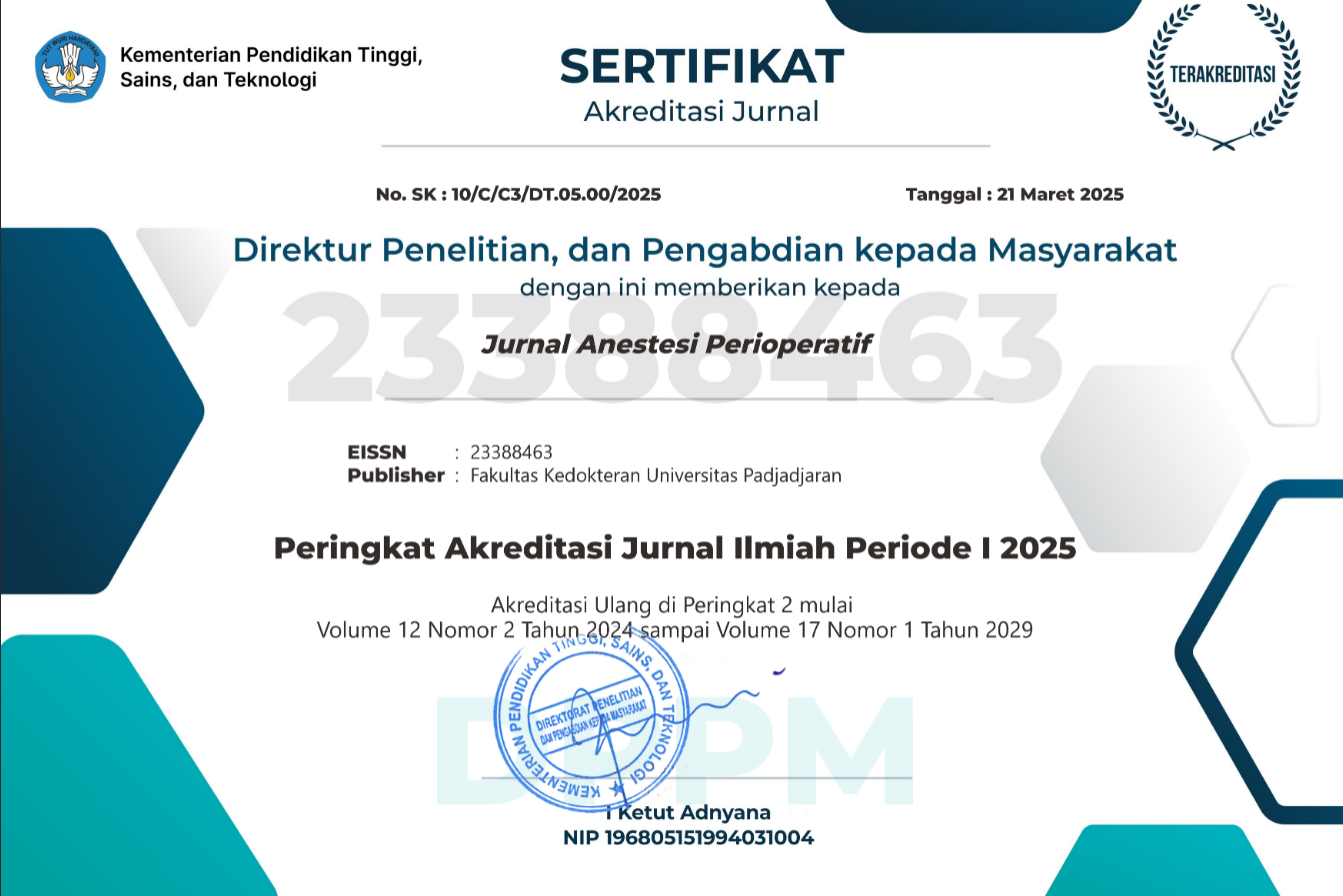Deksametason Intravena dalam Mengurangi Insidens Nyeri Tenggorok Pascabedah
Abstract
Anestesia umum dengan pipa endotrakeal digunakan untuk memberikan ventilasi tekanan positif dan mencegah aspirasi, namun penggunaannya dapat menimbulkan komplikasi nyeri tenggorok pascabedah. Penelitian ini dilakukan membandingkan efektivitas deksametason intravena dengan triamsinolon asetonid topikal dalam mengurangi nyeri tenggorok pascabedah. Penelitian ini merupakan uji klinis acak tersamar ganda yang dilakukan selama bulan Maret–April 2013 di Rumah Sakit Cipto Mangunkusumo pada pasien yang menjalani pembedahan dalam anestesia umum menggunakan pipa endotrakeal. Subjek dibagi menjadi dua kelompok, kelompok deksametason sebanyak 61 orang dan kelompok triamsinolon sebanyak 60 orang. Sebelum induksi, pasien dalam grup deksametason diberikan 10 mg deksametason intravena dan pasta plasebo dioleskan pada balon pipa endotrakeal. Pasien dalam grup triamsinolon diberikan 2 mL NaCl 0,9% intravena dan pasta triamsinolon asetonid dioleskan pada balon pipa endotrakeal. Skor nyeri tenggorok pascabedah dievaluasi sesaat setelah pembedahan berakhir, 2 jam dan 24 jam pascabedah. Hasil penelitian, tidak didapatkan perbedaan bermakna pada kedua kelompok kejadian nyeri tenggorok pascabedah sesaat setelah pembedahan berakhir (27,9% pada kelompok A dan 18,3% pada kelompok B, p=0,214). Triamsinolon asetonid topikal memiliki efektivitas yang sama dengan deksametason intravena dalam mengurangi insidens nyeri tenggorok pascabedah.
Kata kunci: Deksametason, intubasi endotrakeal, nyeri tenggorok pascabedah, pasta triamsinolon asetonid
Comparison between Topical Triamcinolone Acetonide and Intravenous Dexamethasone in Reducing Postoperative Sore Throat Incidence
Tracheal intubation is often used to give positive-pressure ventilation and prevent aspiration during general anesthesia. However, the use of this airway device can cause postoperative sore throat (POST). This study was conducted to compare the effectiveness of prophylactic intravenous dexamethasone and triamcinolone acetonide paste in reducing POST. This study was a double-blind randomized clinical trial conducted during April–May 2013 in Cipto Mangunkusumo General Hospital on patients scheduled for surgery under general anesthesia using endotracheal tube. Subjects were randomly allocated into two groups; 61 patients in dexamethasone group and 60 patients in triamcinolone group. Before induction, the dexamethasone group received 10 mg of intravenous dexamethasone and placebo paste on the endotracheal tube cuff. Triamcinolone group received 2 mL of intravenous normal saline and triamcinolone acetonide paste on the endotracheal tube cuff. POST scores were evaluated immediately after the operation, 2-hours, and 24-hours after the operation. There was no significant difference in the incidence of POST immediately after the operation between the two groups (27.9% in group dexamethasone vs 18.3% in group triamcinolone, p=0.214). Topical triamcinolone acetonide is equally effective compared to prophylactic intravenous dexamethasone in reducing the incidence of POST.
Key words: Dexamethasone, endotracheal intubation, posts operative sore throat, triamcinolone acetonide paste
Keywords
Full Text:
PDFArticle Metrics
Abstract view : 884 timesPDF - 1586 times
This Journal indexed by

JAP is licensed under a Creative Commons Attribution-NonCommercial 4.0 International License
View My Stats



